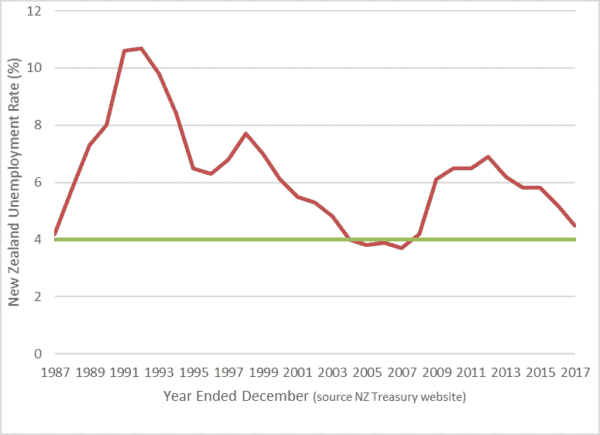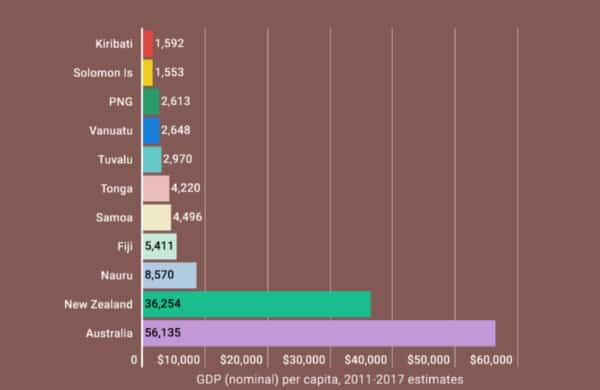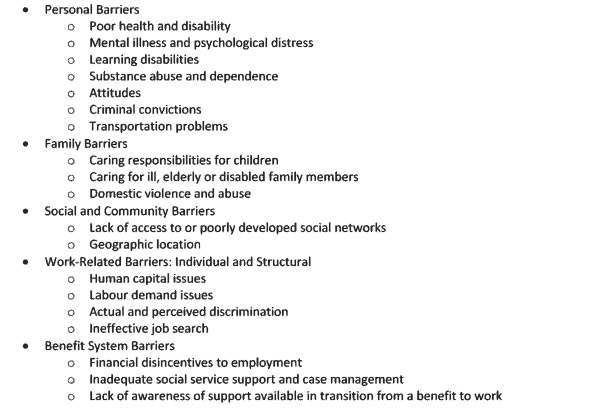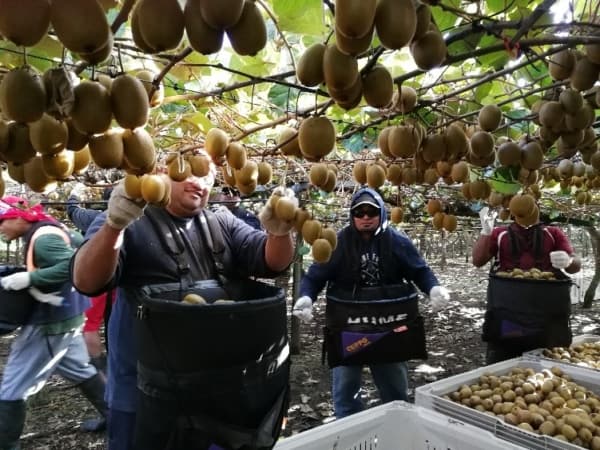Horticulture Labour Issues – enduring solutions needed
As first seen in the Orchardist, June 2018
Sandy Scarrow, Horticultural Consultant Fruition Horticulture (BOP) Ltd, Tauranga
I write this article as the pipfruit harvest is coming to an end and the kiwifruit industry has just completed the harvest of a record 65 million trays of Gold kiwifruit and is embarking on the main pick of Green kiwifruit. There has been significant media coverage of the issues both industries have faced in getting workers to pick and pack this fruit. Other horticulture sectors are facing similar difficulties. The media coverage reports industry pundits with simplistic answers to the issue. Some solutions such as “Just pay people more” or “Just train them and they’ll be able to pick faster” are offered up. In my view these solutions are too simplistic. Thought needs to be given to whole problem to generate enduring solutions. Many in the industry are working on these enduring solutions. This article is written as a “think piece” around this issue – aiming to highlight some of the issues but unfortunately not providing many answers.
Full Employment
One issue that hasn’t been addressed, and even ignored by many is that New Zealand is technically approaching “full employment”. Full employment is an economic term for when almost everyone in an economy, who wants to work, is either in employment or moving between jobs or study. This level is nominally 4%. Figure 1 shows the rate of unemployment in New Zealand over the past 30 years. The solid green line is the 4% full employment level. By the end of 2017, the level of unemployment was approaching this green line, similar to where is was in 2004 – 2006 when again the horticultural industry struggled to get the workers needed to tend, harvest and pack crops.
Figure 1: New Zealand Unemployment Rate Compared with the Full Employment Level

At this level of employment, the industry needs to find a way to attract people away from their existing employment, from study or those few remaining people registered as job seekers into horticulture. This is a work programme that Horticulture New Zealand and others have been focusing on for many years.
A 2014 report suggests that the industry will see a net increase of 7,800 workers by 2025 if the planned industry strategies are to be realised[1]. This same report states that another 26,300 people are required to replace the natural attrition of workers from the industry. Where are these workers going to come from and how are we going to hang on to those we have?
Seasonal Nature of the Work
Another thing that is not acknowledged sufficiently is that much of the work by its very nature is seasonal. Because of the seasonal nature of the work, it is unlikely that workers in good full-time roles will move into seasonal roles in horticulture. It just doesn’t make economic sense for them to do so. Workers therefore need to be sourced from elsewhere.
The Recognised Seasonal Employer (RSE) scheme is brilliant in that it has acknowledged the seasonal need for workers and has sourced labour from our neighbours in the Pacific and elsewhere who struggle to find well paid work for their population. Figure 2 provides graphic representation of the relative Gross Domestic Product (GDP), and indicator of relative wealth, of Australia, New Zealand and our Pacific neighbours.
Figure 2: Relative Wealth of RSE Sending Countries compared with New Zealand and Australia

NEETs
One pool of people who present a real opportunity are those classified as Not in Education, Employment or Training, otherwise known as NEETs. While the level of unemployment overall is dropping, there has been an increase of those aged between 15 and 24 in this NEET category. The proportion of these NEETs increased to 12.4% at the end of March 2018.[2] Just over 600,000[3] of our population are within this age bracket, so there are just under 75,000 NEETs in New Zealand. This is a group of people who need to be targeted to fill the industries needs for permanent workers. A successful strategy to bring these people into the industry will be a win:win:win for the industry, the individuals and New Zealand as a whole.
Many of those in this NEET category are Maori or Pacific Island people. They are likely to be those for whom their career was beginning as New Zealand was impacted by the Global Financial Crisis in 2007/08 who have been left to languish on a benefit as the country recovered.
To encourage these people into the horticultural industry needs concerted effort and there are already some great programmes focusing in this area. The industry needs to look at the barriers that exist to moving from a benefit into employment and find solutions. A 2003 report highlighted the barriers to employment among beneficiaries[4]. These barriers are listed below and are unlikely to have changed since this report was written.

Thinking about those NEET, what can we as a nation, an industry and as individual workplaces do to make them think about an opportunity in horticulture in preference to a life on income support? Following is a brainstorm of some ideas I have – some of which are already being implemented with varying success across New Zealand.
- Make the workplace more welcoming of those with disability, and those who have domestic responsibilities. This is being done in many workplaces by offering split shifts or shifts that work in with school hours. Creches have also been established in some work places.
- Enable workers to acknowledge times of mental stress, including those experiencing domestic violence, and allow the time needed to return to a healthy equilibrium without risking their role. This may include allowing for job-sharing of roles or letting people take time away from work to do whatever they need to in full knowledge that their job will be there for them when they return.
- Don’t discriminate against those with no or low skills where the required skills are learnable, even advertise that those with no qualifications are welcome to apply, in-job training will be given. Also support the training programmes that are focusing on this cohort.
- Align drug testing policies so that impairment rather than use is tested for.
- Current negative media coverage, epitomised by the establishment of the New Zealand Kiwifruit Workers Alliance facebook page, of the abuses that are occurring within horticulture damage the image of the industry no end. It would be great if as an industry we could refute the negative media coverage but we can’t hold our hands on our heart and say it doesn’t occur because we all know it does. Attitudes about the industry will only change when the culture within the industry changes. We all need to take responsibility for this. We need to call out bad practice and support those who are the victims of this bad practice to seek legal redress.
- Tap into all the social networks that exist within your workplace to ensure that you reach out to all those within the local community who may be available for work. If networks don’t exist into some communities, do what you can to establish meaningful engagement with those communities. This might mean encouraging workers to join clubs and attend various functions to expand contacts in your community.
- Establish networks with the Corrections Department or the New Zealand Community Probation Service to give those with a criminal past a chance. There is some great work being done with the Corrections Department and employers moving people into horticultural work.
- Provide either transport or accommodation to make your workplace accessible to those living some distance from it.
- Think about your workplace – is it welcoming of people of different cultures (and culture here is meant in the widest sense). What can you do to make it more welcoming of those who may not fit the existing cultural profile of your workplace?
- What can you as an employer do to reduce financial disincentives? This may include:
- Providing guaranteed hours of work as someone transitions from the benefit to employment
- Reimbursing staff for travel time and expenses if travelling between orchards
- Reimbursing staff for downtime such as time spent waiting for kiwifruit to dry before harvest can begin.
- What is done to ease someone back on to a benefit at the end of seasonal work. I understand for some, the risk of being stood down from a benefit at the end of the season is too great. They would prefer to remain on the relatively low income available to them on a benefit than risk losing what little they have and upsetting family stability for a short-term role in paid employment.
- What can you do to enable access to appropriate support when and if workers struggle? Do you have a list of support agencies who can provide the help needed and enable workers time to access such agencies?
Figure 3: RSE workers harvesting kiwifruit

In summary, there are some key issues that need to be focused on to secure labour for our growing future. These need to be looked at from the government perspective, industry and within your own workplace.
Government
- Continued support of the RSE scheme including more flexibility around the cap at times of full employment.
- Policies and procedures that allow for a smooth transition for those on income support into work and back again.
- Continued funding of programmes that support NEET, and others, into the horticultural industry.
- Increased enforcement of labour laws to move the bad operators out of the industry.
Industry
- Continued promotion of the horticultural industry as a career opportunity.
- Incentives for those who have good labour practices and disincentives for those who don’t.
Individual Workplaces
- Check how your workers are feeling about their workplace. Make any improvements suggested – you don’t want to lose the workers you already have.
- Support contractors and others who have good labour practices and report those who don’t.
- Do what you can to make your workplace welcoming to those who are coming into the industry to ensure their experience is positive.
- Support programmes that bring new people into the industry.
These solutions presented above will go someway to closing the gap currently experience between labour supply and demand.
[1] Future Capability Needs for Primary Industries – April 2014, Nimmo-Bell and Infometrics
[2] https://www.stats.govt.nz/news/unemployment-and-underutilisation-rates-both-fall
[3] https://www.indexmundi.com/new_zealand/demographics_profile.html
[4] Barriers to Employment among Long-term Beneficiaries: A review of recent international evidence. Susan B Singley, Centre for Social Research and Evaluation, June 2003